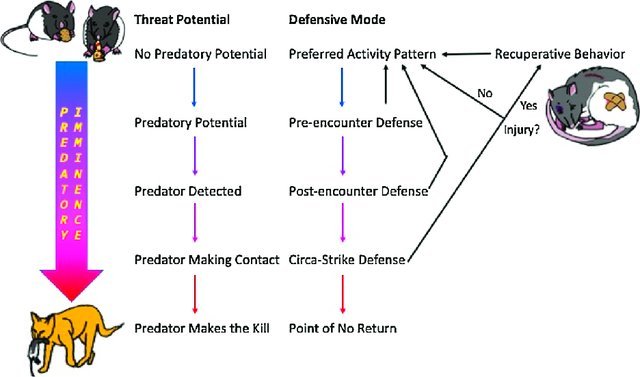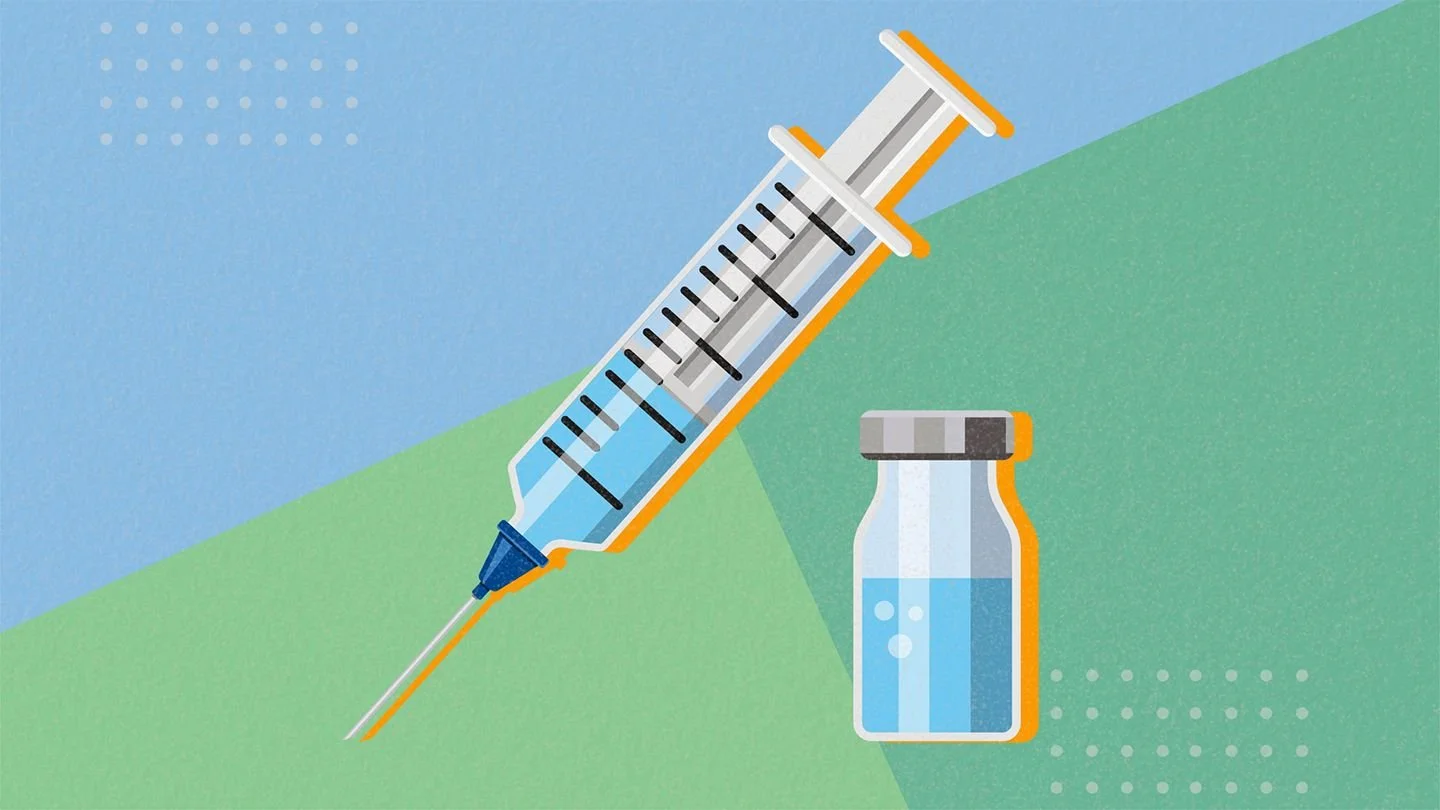The neurobiology of fear and escape from predators
Defining Fear and Anxiety
Fear is the stress response to an immediate danger, such as a shark. A stress response from just your thoughts, such as worrying about the potential of a shark, is known as anxiety. || Source: Fear versus Stress explained (gostrengths.com)
Have you ever wondered why we are afraid of what we are afraid of? Are some of the fears we have normal? What defines when our fear, instead, becomes a pathological disorder? For decades, scientists have argued about what defines fear, and still haven’t agreed upon how it differs from anxiety. Researcher Michael Fanselow suggests that fear is merely an interactive response between the brain and behavior (such as freezing or fleeing) driven by a threatening stimulus (such as a predator). The act of freezing or fleeing serves to protect the organism from danger or threat. When the animal freezes, they hope to go unseen by the predator; when fleeing, the animal runs to try to escape harm. On the other hand, researcher Joseph Ledoux believes that fear is always a conscious and subjective experience and thus unique to humans. What about animals in this case? Some scientists believe that animals only have the ability to engage in defensive-survival behaviors, which are more hard-wired and can occur without explicitly having a feeling of fear (Mobbs et al., 2019).
An example of a fearful face. Notice the raised eyebrows, half-opened mouth, and tension around the facial and neck muscles. || Source: Fear facial expression analyzed - PsychMechanics
Despite these academic debates on the definition of fear, I bet you can easily imagine what a fear response looks like. Raised eye-brows, a half-opened mouth, increased heart rate, and even increased perspiration. These behavioral and physical changes may also manifest as an increased startle response – can you recall a time when a friend jumped out from a hiding spot and tried to scare you? – where you may jump back and gasp in terror. This startle response is actually a reflexive action, designed to keep you safe when faced with danger.
Anxiety is defined by the American Psychological Association (APA) as an emotion characterized by tension, worried thoughts, and physiological changes such as increased heart rate and perspiration (APA, 2023). While the difference between anxiety and fear is very nuanced, it is generally agreed upon that fear occurs when the threat is present and known, whereas anxiety occurs when the threat is unknown or imagined. If you are on a walk and see a snake, you may be afraid and have a fear response of freezing. However, fear can easily turn into anxiety; even if the snake is a considerable distance away, you may think about the consequences of being bitten and may even become nervous to go hiking in the future along that trail. Anxiety can be caused from objects, situations, or places (called phobias) that, for most people, don't typically cause a fear or anxiety response or aren’t inherently dangerous. There are many types of phobias, including the fear of leaving one’s own home, germs, or tight spaces. There are also numerous subtypes of anxiety disorders, including post-traumatic stress disorder (PTSD), panic disorder, obsessive compulsive disorder (OCD), and generalized anxiety disorder (GAD). Generalized anxiety disorder is most associated with people referring to “anxiety disorder”, as it encompasses generic, chronic angst, worry, and tension, even with nothing to drive them. As such, this article will use anxiety disorder to mean GAD.
While anxiety and fear may be slightly distinct, they have more similarities than differences (Wattanabe & Fletcher, 2021) and the behavioral responses are often visually identical. But do fear and anxiety look similar in the brain?
The Neurobiology of Fear and Anxiety
The first step toward the neurological processes of anxiety or fear is identifying a threatening stimulus; this can be from a visual scene, from an odor cue (called olfaction), and/or from an auditory stimulus (such as a growl, gunshot, or scream). These threatening cues are transduced into a neural signal which, in some cases, is sent directly to a brain region called the thalamus. The thalamus acts as a relay station to send signals to other brain regions; think of it like Grand Central Station.
There are two main fear pathways. A “low road” going from the thalamus to the amygdala, which is the “smoke detector” of the brain; this pathway exists to preserve immediate safety. However, an alternative “high road” pathway exists from the thalamus to the prefrontal cortex, to help turn off the amygdala as needed and lower the fear response. || Source: Anxiety and the Brain: The High Road and The Low Road – Brie Childress, LISW-CP – Anderson, SC
After the thalamus, the signal is then sent to the major brain region associated with fear, called the amygdala. The amygdala acts like a smoke detector by helping us to identify when something dangerous is in our environment. This is termed the “low road” pathway or circuit (thalamus → amygdala), as it quickly sends the fear signal to the major emotional center of the brain so that we can form a quick behavioral response to avoid danger! However, another pathway/circuit termed the “high road” can send the same fear signal from the thalamus to the prefrontal cortex, and then back to the amygdala. The prefrontal cortex is broadly involved in decision making, planning, and can even reduce the fear response if needed. Whereas the “low road” allows a fast and robust response to avoid danger, the “high road” allows us to reappraise the situation and turn off the amygdala to reduce our fear response. Finally, after receiving the neural signals from the thalamus or the prefrontal cortex, the amygdala then sends information to other brain regions such as the periaqueductal gray and hypothalamus, where the body and brain release hormones to prepare to respond appropriately to escape harm's way (Kozlowska et al., 2015).
Even in the brain, anxiety and fear often activate similar neural pathways. In a sense, anxiety could be thought to hijack and change the functionality of the underlying fear circuitry. With anxiety, connections between brain regions in the “high road” pathway can become disrupted, and the “high road” can lack the ability to turn off the amygdala (Liu et al., 2020), leading to an overall increased response to environmental stimuli that might not have otherwise needed a fear or anxiety response. Furthermore, a brain region called the bed nucleus of the stria terminalis (BNST; otherwise known as the extended amygdala) is a unique brain region associated with anxiety. While its role in anxiety is still being studied, the BNST is thought to be involved in constantly waiting for a threat to present itself (Avery et al., 2014), which is a hallmark of generalized anxiety disorder. Earlier in this article it was mentioned that fear and anxiety ultimately serve the purpose to keep you safe from harm. However, an anxiety disorder does too good of a job with this task. As a result, people may engage in unnecessary avoidance behaviors throughout their daily life, as more truly harmless situations may become misassociated with danger in the brain.
Escape from Danger: The Threat Imminence Continuum
The threat imminence continuum starts from no predatory potential to a predator making a kill, which changes the rats behavior as the predator draws closer. || Source: (PDF) Timing and the Transition Between Modes in the Defensive Behavior System (researchgate.net) || Citation: Fanselow, M, Hoffman, A. & Zhuravka, I. (2019). Timing and the Transition Between Modes in the Defensive Behavior System. Behavioural Processes. 166, 103890.
But what do we do when we are faced with a threat? Well, researchers have examined a predator imminence continuum in rat models, where both the behavior and brain activity changes depending on how close a threat is in the environment. In cases where there is no threat present, the animal will engage in behaviors such as foraging for food or looking for a mate. When there is potential for a predator to be present in the environment, but there is no predator in sight, the rat will engage in pre-encounter behavior where it carefully surveys the surrounding environment in preparation for encountering a predator. In humans, this pre-encounter defense might look more closely like anxiety behavior. When a predator is encountered in the environment, the rat will enter a post-encounter defense mode and display fear, which is typically freezing behavior but can also entail fleeing. Finally, when the predator is about to strike, the rat will enter a circa-strike mode where the rat will bite, fight, or attempt to escape the environment and neutralize the threat (Fanselow et al., 2018).
Is there evidence of these behavioral modes in humans? An interesting study by Mobbs and colleagues (2007, 2009) used an fMRI machine to measure brain activity in humans after giving them a shock to their hands (to mimic being attacked by a predator). As the “predator” grew closer to participants on a virtual screen, the participants had more self-reported dread and anxiety, and made more panicked motor movements! These physiological and behavioral changes were further associated with adjustments in brain activity. At pre-encounter phases the prefrontal cortex was engaged (part of the “high road”), at post-encounter phases the amygdala was activated (the “low road”), and at circa-strike phases, when the participants were more fearful of the shock, the periaqueductal gray was activated (Mobbs et al., 2009, Mobbs et al., 2007). The periaqueductal gray helps us quickly act when danger is near. Interestingly, this experiment helped show that humans and rats likely engage in a similar range of behaviors when encountering threat, and we need research in both rats and humans together to help understand exactly how we make decisions when in danger. While the fear responses described in this section are in reaction to real environmental threats, it is also possible for us to learn to be fearful of ordinary objects or situations through a process called fear conditioning.
Fear Conditioning
The pairing of a bell and food triggers a salivating response in the dog when later presented merely with the bell, a process called classical conditioning. The process of classical conditioning is the basis of fear conditioning, in which a neutral stimulus is paired with a threatening stimulus. || Source: Classical conditioning - Wikipedia
If you were to present your dog with food, they will undoubtedly start to salivate, which is a normal response to some delicious Purina. However, imagine if you rang a bell immediately prior to presenting your dog with food. By itself, the bell doesn’t do much, other than maybe annoy your dog a little. However, if every time you give food you start by ringing the bell, the dog will eventually learn that the bell predicts the delivery of the food. As a result, your dog might start salivating at the presentation of simply the bell! This idea is the process of conditioning, otherwise known as classical conditioning or Pavlovian conditioning (named after the experimenter who made this discovery, Ivan Pavlov).
Similar to this example, we can become conditioned to have a fearful response to the presentation of objects if they have previously been paired with a threatening situation. The most famous example is that of little Albert, a baby who was shown a rat and then exposed to a loud noise. Like the bell in the previous example, the rat by itself elicited no behavioral response. Similarly, like food normally caused the dog to salivate, the loud noise caused little Albert to have a startle response (he would jump at the sound of the noise). After repeatedly presenting the rat followed by the loud noise, little Albert began to fear the rat by itself. Furthermore, little Albert’s fear of rats began to extend to all animals that looked similar to rats.
In this example, little Albert developed a phobia, or a fear of a specific object. Importantly, in some cases, if you keep presenting the now-feared object without a corresponding threat, the individual will re-learn that the object is NOT dangerous. For instance, if little Albert continued to be presented with the rat without the loud noise, he might eventually stop being fearful of the rat by itself. This process is called extinction learning. Not being able to engage in proper extinction learning is a hallmark of post-traumatic stress disorder (PTSD), which is a type of anxiety disorder. Therefore, understanding fear conditioning and extinction in the rodent brain is essential in trying to find cures for PTSD, and in helping us understand how humans learn to be afraid of what we are afraid of. While fear conditioning can sometimes be harmful for us if it causes an anxiety disorder, it can also be a helpful way to keep us safe and avoid dangerous situations. Imagine if you had food poisoning every time you ate strawberries ; you would most likely stop eating strawberries and it is possible you would no longer find strawberries tasty. This is because the brain has made an association between strawberries and your food poisoning, and determined that strawberries could be dangerous to you or a cause of your illness. The brain tells you to avoid the food because it wants to keep you safe, even if it’s wrong and strawberries aren’t the actual cause of your illness!
Anxiety and Fear: What can we do?
As mentioned previously, fear isn't a bad thing. In fact, without fear you would constantly be walking into harm's way. We don’t want to eliminate fear altogether, but instead make sure that our behavioral responses function properly along the threat imminence continuum, as we become closer or further to harm. In that regard, anxiety is a pathological (disordered) manifestation of fear, in which we are fearful of objects or situations that aren’t inherently harmful (e.g. through fear conditioning!). Anxiety could be described as being in a constant state of pre-encounter… waiting for a threatening stimulus to present itself. Being in this constant state of anxiety does allow us to avoid harm, but it happens at a cost: anxiety is often associated with increased headaches, increased blood pressure, and muscle pains. Fortunately, we know of many ways to reduce stress and anxiety. In addition to therapy, things such as getting enough sleep, diet, exercise, and even exploring your creative side are great ways to relax and turn down the activity levels of those fear and anxiety centers of your brain.
Conclusion
Fear is an important mechanism that the brain has to promote our survival; we certainly want to avoid danger and engage in the best possible action or behavior to do so. However, anxiety can easily manifest when we are afraid of things that aren’t an actual danger to our lives, such as an upcoming exam or the termination of a relationship. Fear and anxiety share many neurological pathways and brain regions, so our understanding of one may shed some light on how the other works. Animal work involving fear and fear conditioning is thus essential in understanding human anxiety disorders (for more information on the benefits of the use of animals in research, please see https://psbr.org/animal-research). Lastly, there are many things you can do in your daily life to reduce your anxiety and stress levels, but remember that not all fear is a bad thing!
References:
Avery, S. N., Clauss, J. A., & Blackford, J. U. (2016). The Human BNST: Functional Role in Anxiety and Addiction. Neuropsychopharmacology : official publication of the American College of Neuropsychopharmacology, 41(1), 126–141. https://doi.org/10.1038/npp.2015.185
Daniel-Watanabe, L., & Fletcher, P. (2021). Are Fear and Anxiety Truly Distinct? Biological Psychiatry Global Open Science, 2, 341-349.
Fanselow M. S. (2018). The Role of Learning in Threat Imminence and Defensive Behaviors. Current opinion in behavioral sciences, 24, 44–49. https://doi.org/10.1016/j.cobeha.2018.03.003
Kozlowska, K., Walker, P., McLean, L., & Carrive, P. (2015). Fear and the Defense Cascade: Clinical Implications and Management. Harvard review of psychiatry, 23(4), 263–287. https://doi.org/10.1097/HRP.0000000000000065
Liu, W. Z., Zhang, W. H., Zheng, Z. H., Zou, J. X., Liu, X. X., Huang, S. H., You, W. J., He, Y., Zhang, J. Y., Wang, X. D., & Pan, B. X. (2020). Identification of a prefrontal cortex-to-amygdala pathway for chronic stress-induced anxiety. Nature communications, 11(1), 2221. https://doi.org/10.1038/s41467-020-15920-7
Mobbs, D., Adolphs, R., Fanselow, M. S., Barrett, L. F., LeDoux, J. E., Ressler, K., & Tye, K. M. (2019). Viewpoints: Approaches to defining and investigating fear. Nature neuroscience, 22(8), 1205–1216. https://doi.org/10.1038/s41593-019-0456-
Mobbs, D., Petrovic, P., Marchant, J. L., Hassabis, D., Weiskopf, N., Seymour, B., Dolan, R. J., & Frith, C. D. (2007). When fear is near: threat imminence elicits prefrontal-periaqueductal gray shifts in humans. Science (New York, N.Y.), 317(5841), 1079–1083. https://doi.org/10.1126/science.1144298
Mobbs, D., Marchant, J. L., Hassabis, D., Seymour, B., Tan, G., Gray, M., Petrovic, P., Dolan, R. J., & Frith, C. D. (2009). From threat to fear: the neural organization of defensive fear systems in humans. The Journal of neuroscience : the official journal of the Society for Neuroscience, 29(39), 12236–12243. https://doi.org/10.1523/JNEUROSCI.2378-09.2009


















